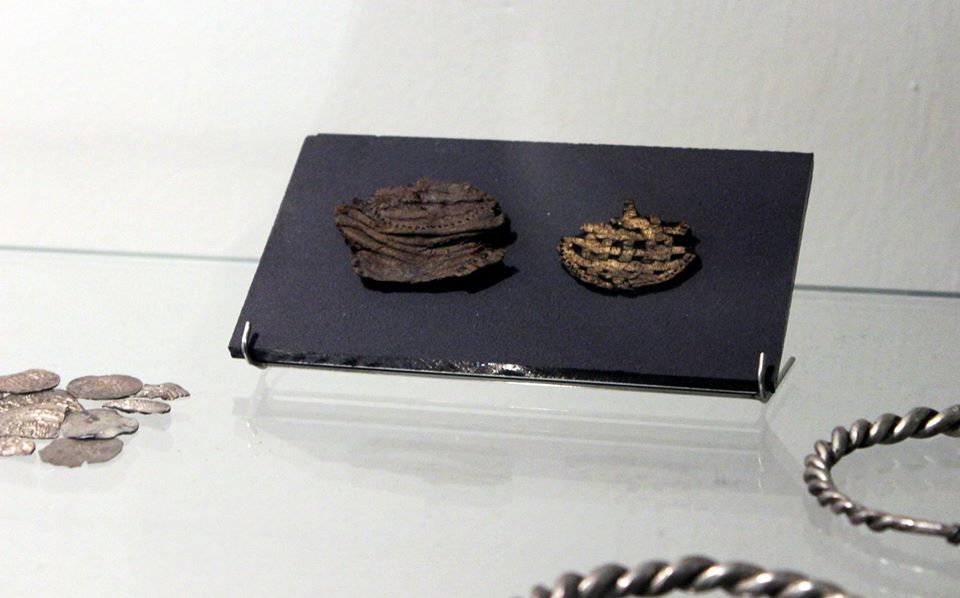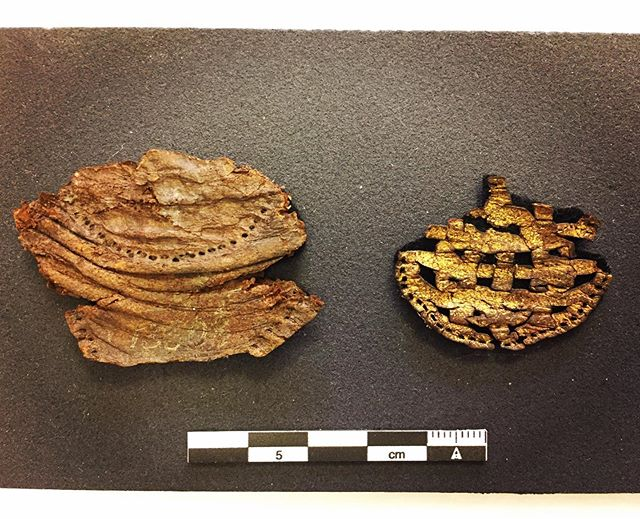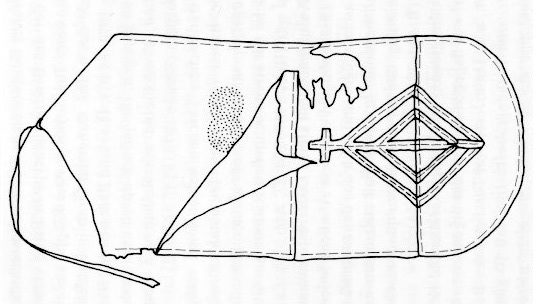In March 2020, I was notified of an interesting find of a wallet from 11th century Denmark, which has not been paid much attention. This brief article will provide basic information on the entire find and the reconstruction attempts.
Circumstances of the find and its content
On a Sunday in 1853, an unnamed brick factory worker from Tåsinge, Denmark, went to uninhabited island of Iholm, which lies in the Svendborg Strait between the islands of Funen and Tåsinge, accompanied by his friends. As he was strolling and destroying molehills, he saw metal reflections in one of them. Inside, he found 15 coins that he had buried again due to fear of disaster and illness, he washed himself and went home. The man shared the information about the discovery with the master brickman, who went to the island with its owner. The find-place, located in the middle of the small island, was thoroughly examined within a radius of about 4 meters and a depth of 1 meter. At a depth of 20-25 cm below the surface, they found a silver treasure that was kept in a leather case, and other silver objects were discovered within a 30 cm radius. The treasure was collected and handed over to the National Museum in Copenhagen (Grundtvig 1948: 170; Skovmand 1942: 90, Cat. No. 32).
The main part of the treasure consisted of 475 coins, more precisely 3 Danish, 1 Norwegian, 17 Swedish, 238 Anglo-Saxon, 10 Dutch, 163 German, 2 Carolingian, 8 Czech, 1 Byzantine, 1 Persian, 27 Kufic and 2 semi-finished coins (Erslev 1875: 119- 120; Hauberg 1900: 165, Cat No. 45; Malmer 1966: 269, Cat No. 43). Duczko informs that the treasure includes two shield pendants with whirl motifs (Duczko 1989: 18). In addition, three fragments of necklaces were found in the treasure (Hårdh 1996: 48, 191), four complete bracelets and ingots (Nationalmuseet 2020; Trap 1923: 706). In 1989, around 100 coins and silver fragments were discovered near the site, so the total number was about 590 pieces of silver (Nationalmuseet 2020). The dating of the treasure is the first quarter of the 11th century; it is usually said to date to 1010 (Nationalmuseet 2020; Trap 1957: 711). The most recent work speaks of a dating after 1002 (Brandt – Mannering 2020). The catalog number of the treasure, which is partially exhibited in the National Museum in Copenhagen (room 23), is C NM 13594-608, C. 1837. The find-place is sometimes also referred as Yholm, Bregninge, Svendborg, Svendborgsund, Tåsinge or Taasinge.
The available literature has always descibed the numismatic part of the treasure (among others Brøndsted 1938: 382; Galster 1980: 65; Rasmusson 1937: 125-6; Schive 1865: 13; Wahlstedt 1930: 23, 28), while the leather fragments remain almost unnoticed by literature. The next chapter will therefore be devoted to the description of leather fragments.
The position of Iholm on the map of Europe.
Wallet remains and reconstruction
But not all the silver that glitters! The wallet in which the treasure was located was no less valuable and was a representative item. In the present state, it consists of two leather fragments – made of Bovidae or Cervidae animal (Brandt – Mannering 2020; Brandt et al. 2022) – one of which is part of the wallet pocket and the other is a sewn application that has been gold-plated (Nationalmuseet 2020; Mannering 2017):
- fragment 1: a piece of leather with approximate size of 6 × 4 cm, which forms the tip of a folding wallet. The side exhibited in the museum as the upper side is the upper side of the inner pocket. The two sides forming the tip are lined with holes for stitches. Apperently, the fragment of the pocket has been sewn to the second, supporting layer. The top of the fragment and the tip are torn apart. The dominating part of the fragment is a semicircle of holes, which was used to find the originally circular application. This application was positioned at the center of the width of the object, with the offset from the sides being smaller than the offset from the tip. Whether the wallet had one or two pockets facing each other is not known, but both variants are possible. The wallet in its original state probably exceeded the width of 6 cm, while the original length is unknown, but due to hundreds of pieces of silver it could be quite large. The closest contextual and shape analogy is the bag from Roswinkel, Netherlands, dated to the end of the 9th century (Pleyte 1883; Gräslund 1984: Abb. 16.2; Vlasatý 2024a). This folding bag consists of a supporting two-part layer and a three-part pocket embellished with a sewn leather application; it was used to store the treasure of circa 145 coins. Other examples of folding wallets are 24 wallets from Birka (Gräslund 1984: 143-6), Sigtuna wallet (Vlasatý 2024b), a small four-piece wallet from Bringsverd, Norway (C23116; Rolfsen 1981: 117) and a small wallet from the Evebø grave, Norway, 5th century (B4590). The presence of a tip at Iholm wallet indicates that the find did not belong to the group of two-piece wallets with integral leather slider, such as those from Elisenhof (Grenander-Nyberg 1985: 234, 247, Taf. 76) and Gniezno (Kurnatowska 2008: 354). With a high degree of probability, we can also exclude it would belong to the group of bags with metal components.
- fragment 2: leather application originally of circular shape. The diameter of this application could be about 3-4 cm, Skovmand says 3.5 cm (Skovmand 1942: 91). The application consisted of an interwoven motif with a rim, with holes for stitches at the edge of the rim. The interwoven motif was apparently made up of two pieces that were perpendicular to each other, one piece consisting of a rim and strips connecting its two sides, while the other had loose ends, which were interwoven between the strips of the furst piece and inserted under the rim and stitched together with the rim. At this time, exact reconstruction of the application is not possible and it is necessary to wait for detailed analysis and publishing in print. However, similar motifs can be found on pendants and textile applications in Viking Sweden. The leather application was gilded with foil, which is still visible today. The closest analogy to this decorative method can be found in Birka, where all parts of folding wallets are interwoven with gilded leather strips (Gräslund 1984: 143-6). A similar find to those from Birka is a metal pouch lid from Frankish grave 10 in Cologne-Müngersdorf, which imitates the interweaving of leather straps or wires (Fremersdorf 1955: 93, 137, Taf. 92.1-2). Close to the finds from Birka is the tin cover of a satchel from Frankish grave No. 10 in Cologne-Müngersdorf, Gilded leather can also be found on the wooden knife sheath from warrior grave excavated at Prague Castle (Borkovský 1939-46: 127). Remains of gilded leather, possibly from a pillow, were found in chamber grave 7 in Pskov (Zubkova – Orfinskaja 2015: 374, Рис. 1). Yet another fragments of gilded leather come from grave 295 in Timerevo (Orfinskaja – Zozulja 2020: 124-5). Notker the Stammerer mentions that Charlemagne wore gilded leather shoes (De Carolo Magno, translated by Thorpe, p. 132).
Source: Fashioning the Viking Age 2019.
Bag from Roswinkel, which is the closest analogy. Source: Gräslund 1984: Abb. 16.2.
As far as we know, two attempts have been made to reconstruct the waller which should be mentioned. The first of these was created in the Danish workshop Nichols Naturligvis. The overall look is great and the only details we can criticize is the size of the application, which covers too big space compared to the original, and the shape of the lower edge, which should be more spiked and probably without a strap. Generally, this attempt copies models from Birka. The workshop is very active in experimenting with the possible looks of the original interwoven motif, which was symmetrical, in their opinion.
 Attempted reconstruction by Nichols Naturligvis.
Attempted reconstruction by Nichols Naturligvis.
The other attempt was made by Swedish reenactor Veronica Wik, who mounted the asymmetric application on a purse. The benefit of this reconstruction is the fact it reflects the larger capacity of the wallet, which should have been able to hold several hundred pieces of silver, as well as a greater offset of the application from the edge, which is more consistent with the original find. We must also appreciate the involvement of coins and hence the pursuit of a realistic concept.
Reconstruction attempt by Veronica Wik.
Since both versions are not ideal, me and reenactor and graphic designer Tomáš Cajthaml prepared two graphic designs that outlines the original appearance of the artifact in the best possible way – the wallet is folding, has only one strap, the application has the correct ratio to the rest and the offset respects the original composition. We used the shape of Roswinkel bag, which we consider the closest shape analogy. The look of the application was taken from the attempt of Veronika Wic, although we are aware that none of the designs is 100% accurate.


Suggested drawn reconstructions of Iholm wallet.
Made by Tomáš Cajthaml.
Acknowledgments and conclusion
Wallet from Iholm is a rare specimen that complements the mosaic of purses, bags and wallets known from the Viking Age. In terms of decorating, it ranks among the top finds. It suggests that gilded leather was a more widespread phenomenon than previously thought. It is also probably the first wallet known from Viking Age Denmark, which will be appreciated especially by reenactors interested in the region who now have the opportunity to take this artifact into consideration. All this should serve as an appeal to the staff of the National Museum in Copenhagen, pointing out that the wallet has not yet been published.
Finally, I would like to thank Nichols Naturligvis for drawing my attention to this find. My thanks also deserve Veronica Wik. In the last, most honorable place, I would like to pay tribute to Tomáš Cajthaml, who quickly and unselfishly created great graphics, thanks to which this artifact can be appreciated by people from all over the world.
Here we will finish this article. Thank you for your time and we look forward to any feedback. If you want to learn more and support my work, please, fund my project on Patreon or Paypal.
Bibliography
Notker the Stammerer: De Carolo Magno. In: Two lives of Charlemagne: Einhard and Notker the Stammerer, translated by Lewis Thorpe, Harmondsworth 1967.
Borkovský, Ivan (1939-46). Hrob bojovníka z doby knížecí na Pražském hradě. In: Památky archeologické 42, 122-131.
Brandt, L. Ø. – Mannering, Ulla (2020). Taxonomic identification of Danish Viking age shoes and skin objects by ZooMS (Zooarchaeology by mass spectrometry). In: Journal of Proteomics.
Brandt, L. Ø. et al. (2022). Palaeoproteomics identifies beaver fur in Danish high-status Viking Age burials – direct evidence of fur trade. In: PLoS ONE 17(7), 1-14.
Brøndsted, Johannes (1938). Danmarks oldtid, bind 3, København.
Duczko, Władysław (1989). Runde Silberblechanhänger mit punzierten Muster. In: Arwidsson, Greta (ed.). Birka II:3. Systematische Analysen der Gräberfunde, Stockholm, 8–18.
Erslev, Kristian (1875). Roskildes ældste Mønter. Studier til Dansk Mønthistorie. In: Aarbøger for nordisk Oldkyndighed og Historie, København, 117–187.
Fashioning the Viking Age 2019 = Fragment of a leather purse from Yholm. In: Fashioning the Viking Age Project [online]. [2020-03-19]. Available here.
Fremersdorf, Fritz (1955). Das fränkische Reihengräberfeld Köln-Müngersdorf, Berlin.
Galster, Georg (1980). Vikingetids møntfund fra Bornholm. In: Nordisk Numismatisk Årsskrift 1977–78, 5–246.
Gräslund, Anne-Sofie (1984). Beutel und Taschen. In: Arwidsson, Greta (ed.). Birka II:1. Systematische Analysen der Gräberfunde, Stockholm, 141-154.
Grenander-Nyberg, Gertrud (1985). Die Lederfunde aus der frühgeschichtlichen Wurt Elisenhof. In: Szabo, Mátyás et al. (eds.). Die Holzfunde aus der frühgeschichtlichen Wurt Elisenhof. Die Lederfunde aus der frühgeschichtlichen Wurt Elisenhof. Elisenhof Band 5, Frankfurt – Bern – New York.
Grundtvig, Sven (1948). Danske folkesagn, 1839-83: samling. Danske stedsagn, København.
Hårdh, Birgitta (1996). Silver in the Viking Age: A Regional-Economic Study (Acta Archaeologica Lundensia, Series in 8° Nr. 25), Stockholm.
Hauberg, Peter Christian (1900). Myntforhold og udmyntninger i Danmark indtil 1146, København.
Kurnatowska, Zofia (2008), Początki i rozwój państwa. In: Kobusiewicz, Michał (ed.). Pradzieje Wielkopolski: od epoki kamienia do średniowiecza, Poznań, 297–395.
Malmer, Brita (1966). Nordiska mynt före år 1000 (Acta Archaeologica Lundensia, Series in 8° Nr. 4), Lund.
Mannering, Ulla (2017). Skattefundet fra øen Yholm. In: Nationalmuseet – Prehistory [online]. [2020-03-19]. Available here.
Nationalmuseet (2020). Udsøgt læderpung med guldtryk. In: Nationalmuseet i København [online]. [2020-03-19]. Available here.
Pleyte, Willem (1883). Nederlandsche Oudheden van de vroegste tijden tot op Karel den Groote, Leiden.
Orfinskaja – Zozulja 2020 = Орфинская, О. В. – Зозуля, С. С. (2020). Пряденые, плетеные и тканые изделия из могильника Большое Тимерево в собрании Государственного исторического музея // Genesis: исторические исследования 6, 118 – 135.
Rasmusson, Nils Ludvig (1937). Kring de västerländska mynten i Birka. In: Från stenålder till rokoko, studier tillägnade Otto Rydbeck, Lund, 113–135.
Rolfsen, Perry (1981). Den siste hedning på Agder. In: Viking, Vol. 44, 112–128.
Schive, G. I. (1865). Norges Mynter i Middelalderen, samlede og beskrevne af G. I. Schive: Med Indledning af C. A. Holmboe, Christiania.
Skovmand, Roar (1942). De danske Skattefund fra Vikingetiden og den ældste Middelalder indtil omkring 1150. In: Aarbøger for nordisk oldkyndighed og historie, København, 1-275.
Trap, Jens Peter (1923). Kongeriget Danmark, 4. Udgave, København.
Trap, Jens Peter (1957). Kongeriget Danmark, 5. Udgave : Odense og Svendborg Amt, København.
Vlasatý, Tomáš (2024a). The Bag from Roswinkel, Netherlands. In: Project Forlǫg – Reenactment and science [online]. [2024-01-15]. Available at: https://sagy.vikingove.cz/en/the-bag-from-roswinkel-netherlands/.
Vlasatý, Tomáš (2024b). The Wallet from Sigtuna, Sweden. In: Project Forlǫg – Reenactment and science [online]. [2024-02-14]. Available at: https://sagy.vikingove.cz/en/the-wallet-from-sigtuna-sweden/.
Wahlstedt, Axel (1930). Den svenska plåtmyntningens historia. In: Numismatiska meddelanden 25, 22-36.
Zubkova – Orfinskaja 2015 = Зубкова, Е. С. – Орфинская, О. В. (2015). Текстиль из камерных погребений Старовознесенского некрополя Пскова // Древнерусский некрополь Пскова X – начала XI в.: В 2 т. Т. 2. Камерные погребения древнего Пскова X в. (по материалам археологических раскопок 2003 – 2009 гг. у Старовознесенского монастыря), СПб., 373–394.





2 Responses
Hi, was wondering if you have the article you cited
Gräslund, Anne-Sofie (1984). Beutel und Taschen. In: Arwidsson, Greta (ed.). Birka II:1. Systematische Analysen der Gräberfunde, Stockholm, 141-154.
I can’t find it anywhere and I’m getting a little desperate. Thanks for the article!
Hello,
I am sending the article to your email.